
Eucalyptus dives, commonly known as the broad-leaved peppermint or blue peppermint, is a species of tree that is endemic to south-eastern Australia. It has rough, finely fibrous bark on the trunk and larger branches, smooth bark above, lance-shaped or curved adult leaves, flower buds in groups of eleven or more, white flowers and cup-shaped, hemispherical or conical fruit.

Eucalyptus melliodora, commonly known as yellow box, honey box or yellow ironbark, is a species of medium-sized to occasionally tall tree that is endemic to south-eastern, continental Australia. It has rough, flaky or fibrous bark on part or all of the trunk, smooth greyish to yellowish bark above. The adult leaves are lance-shaped to egg-shaped, the flower buds are arranged in groups of seven and the fruit is more or less hemispherical.

Eucalyptus lansdowneana, commonly known as the crimson mallee or the red-flowered mallee box, is a species of slender stemmed, straggly mallee that is endemic to a restricted area of South Australia. It has rough, fibrous or flaky bark at the base, smooth, grey over creamy-white bark, lance-shaped adult leaves, flower buds in groups of seven, crimson flowers and barrel-shaped fruit.
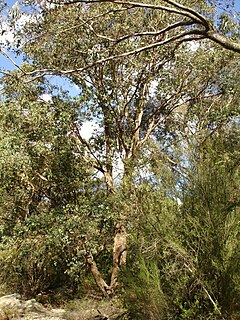
Eucalyptus baueriana, commonly known as blue box or round-leaved box, is a tree that is endemic to south-eastern Australia. It has rough, fibrous or flaky bark on the trunk and branches, egg-shaped adult leaves, oval to diamond-shaped flower buds arranged in groups of seven, white flowers and conical fruit.
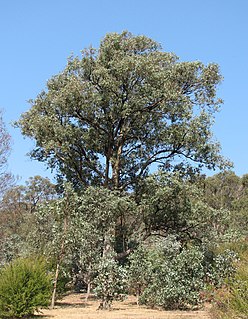
Eucalyptus polyanthemos, commonly known as red box, is a species of small to medium-sized tree, that is native to eastern Australia but has been introduced into other countries. It has fibrous bark on the trunk and larger branches, smooth greyish to cream-coloured bark above, or smooth bark throughout. It has broadly egg-shaped to round juvenile leaves, lance-shaped, egg-shaped or almost round adult leaves, flower buds in groups of seven, white flowers and barrel-shaped to conical fruit.

Eucalyptus miniata, commonly known as the Darwin woollybutt or woolewoorrng, is a species of medium-sized to tall tree that is endemic to northern Australia. It has rough, fibrous, brownish bark on the trunk, smooth greyish bark above. Adult leaves are lance-shaped, the flower buds are ribbed and arranged in groups of seven, the flowers orange or scarlet and the fruit is cylindrical to barrel-shaped or urn-shaped, with ribs along the sides.

Eucalyptus acmenoides, commonly known as white mahogany or barayly, is a tree that is endemic to eastern Australia. It is a large tree with grey to reddish brown, stringy bark, lance-shaped leaves, oval to spindle-shaped buds and more or less hemispherical fruits. The two sides of adult leaves are very different shades of green.

Eucalyptus foecunda, commonly known as narrow-leaved red mallee, Fremantle mallee or coastal dune mallee, is a species of plant in the myrtle family that is endemic to Western Australia. It has rough bark on the trunk, smooth bark above, narrow lance-shaped adult leaves, flower buds in groups of nine or eleven, creamy white flowers and cup-shaped fruit. It was previously included with the more widespread Eucalyptus leptophylla.

Eucalyptus dealbata, known as the tumbledown red gum or hill redgum, is a species of small tree that is endemic to eastern Australia. It has mostly smooth, white to grey or brownish bark, lance-shaped to egg-shaped adult leaves, flower buds in groups of between seven and eleven, white flowers and hemispherical fruit with the valves extended well beyond the rim of the fruit.
Eucalyptus fitzgeraldii, commonly known as the broad-leaved box or the paper-barked box, is a tree that is endemic to Western Australia. It has rough, flaky bark, flower buds arranged in groups of seven and bell-shaped to urn-shaped fruit.

Eucalyptus lucasii, commonly known as Barlee box, is a species of mallee that is endemic to central Western Australia. It has smooth bark, sometimes rough near the base, with broadly lance-shaped adult leaves, flower buds mostly in groups of between seven and eleven on a branched peduncle, creamy white flowers and cup-shaped to cylindrical or conical fruit.

Eucalyptus lucens, commonly known as the shiny-leaved mallee, is a species of mallee that is endemic to northwestern Australia. It has small, pale greyish to brown bark, glistening, lance-shaped adult leaves, flower buds in groups of seven on a branching peduncle, creamy white flowers and conical fruit.
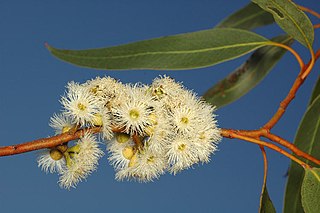
Eucalyptus petraea, commonly known as granite rock box, is a species of mallee or a small tree that is endemic to Western Australia. It has thin, ribbony or flaky to fibrous bark on the lower trunk, smooth greyish above, lance-shaped adult leaves, flower buds usually in groups of seven, creamy white flowers and conical fruit.

Eucalyptus platycorys, commonly known as Boorabbin mallee, is a species of mallee, rarely a small tree, that is endemic to Western Australia. It has rough, dark grey, fibrous and flaky bark on the trunk, smooth greyish bark above, lance-shaped adult leaves, flower buds usually in group of three, creamy white flowers and cup-shaped to cylindrical fruit.

Eucalyptus pruinosa, commonly known as silver box, silver leaf box, apple box or smoke tree, is a species of tree or a mallee that is endemic to northern Australia. The Jaminjung peoples know the tree as yarrirra or jarnbiny, the Jaru as wararn and the Wagiman as wararn. It has rough, fibrous to flaky bark on the trunk and branches, a crown composed of juvenile, glaucous, heart-shaped to broadly elliptical leaves arranged in opposite pairs, flower buds arranged in groups of seven on the ends of branches, creamy white to pale yellow flowers and cylindrical to conical fruit.
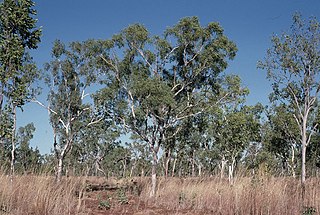
Eucalyptus tectifica, commonly known as Darwin box, or grey box, is a species of tree that is endemic to northern Australia. It has rough, fibrous or flaky bark on the trunk and branches, lance-shaped or curved adult leaves, flower buds usually in groups of seven, creamy white flowers and conical, cup-shaped or barrel-shaped fruit.
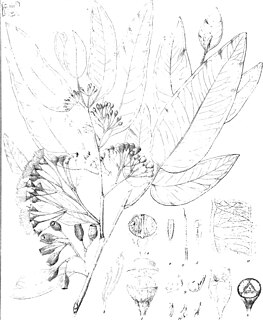
Corymbia clavigera, commonly known as apple gum or cabbage gum, is a species of tree that is endemic to a small area in the north-west Kimberley region of Western Australia. It has smooth, pale grey and white bark, lance-shaped or elliptical adult leaves, flower buds in groups of three or seven, white flowers and urn-shaped to barrel-shaped fruit.

Corymbia ferruginea, commonly known as the rusty bloodwood, is a species of tree that is endemic to northern Australia. It has rough, tessellated bark on the trunk and branches, a crown of sessile juvenile leaves, flower buds in groups of three or seven, pale creamy yellow flowers and urn-shaped fruit.

Corymbia setosa, commonly known as the rough leaved bloodwood or desert bloodwood, is a species of small tree that is endemic to north-eastern Australia. It has rough, tessellated brown bark on the trunk and branches, a crown of juvenile, heart-shaped leaves arranged in opposite pairs, flower buds in groups of three or seven, white flowers and urn-shaped to shortened spherical fruit.

Leptospermum divaricatum is a species of plant that is endemic to inland New South Wales. It is an erect or weeping shrub with compact fibrous bark, elliptical to egg-shaped leaves, white flowers arranged singly on short axillary side shoots and woody fruit that fall off when mature.



















